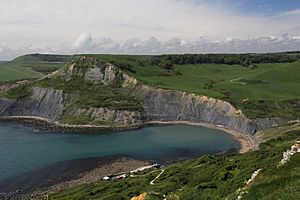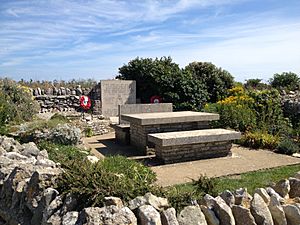Chapman's Pool facts for kids
Quick facts for kids Chapman's Pool |
|
|---|---|

Chapman's Pool, Dorset, seen from Emmetts Hill
|
|
| Lua error in Module:Location_map at line 420: attempt to index field 'wikibase' (a nil value). |
Chapman's Pool is a beautiful, small cove located on the coast of Dorset, England. It's found west of a village called Worth Matravers, within an area known as the Isle of Purbeck. This hidden gem is famous for its interesting rocks and fossils, and it offers stunning views of the Jurassic Coast.
Contents
Rocks and Fossils at Chapman's Pool
The cliffs and rocks at Chapman's Pool are made mostly of a type of rock called Kimmeridge Clay. This clay is very old and is packed with fossils! You can often find flattened bivalves (like ancient clams or mussels) and ammonites (ancient sea creatures with spiral shells).
Sometimes, you might find special, round rocks called "Rotunda Nodules." These nodules are unique because they can preserve fossils in 3D, not just flattened. One important fossil found here is the Pavlovia rotunda ammonite, which helps scientists figure out the age of the rocks.
You might also see some dark, lumpy rocks that look like manganese oxide. These didn't form here naturally. They are actually from the cargo of a ship called the SS Treveal. This ship was wrecked nearby in 1920, and its cargo washed ashore.
Emmetts Hill Memorial Garden
High above Chapman's Pool, on a spot called Emmetts Hill, there is a special memorial garden. It was created to remember members of the Royal Marines who lost their lives. The idea for this garden came after a sad event in 1989, when the Royal Marines Barracks at Deal was attacked.
A man named Colin Dishington helped organize the project. They chose this spot because it has amazing views of the sea and the rugged coastline. It's also an area where the Royal Marines have trained for many years. The land was kindly given by the owner, David Scott.
The first stone at the memorial remembered Royal Marines lost between 1945 and 1990. It has the Royal Marines' symbol and a message for visitors:
Rest awhile and reflect that we who are living can enjoy the beauty of the sea and countryside.
In 2005, another stone was added to remember those lost in more recent conflicts. A special service is held here every year by the Royal Marines Association. A bugler from the Royal Marines Band Service plays during the ceremony.
The garden is looked after by volunteers. Many people walking the coastal path stop here to rest and enjoy the peaceful views. It's a quiet and fitting place to remember the brave Royal Marines.
Chapman's Pool Lifeboat Station
In 1866, many lives were being lost at sea near Chapman's Pool. Because of this, it was decided to build a lifeboat station there. The station was finished in 1867, and a lifeboat named George Scott was placed there.
However, the lifeboat station didn't stay open for long. It closed in 1880. There were a few reasons for this. It was very expensive to keep the boathouse running. Also, landslips (when earth slides down a slope) often damaged the building. Finally, there wasn't a nearby village, so it was hard to find enough local volunteers to help with the lifeboat.
Today, the old lifeboat building still stands. It is now used as a fishing hut.
Gallery








